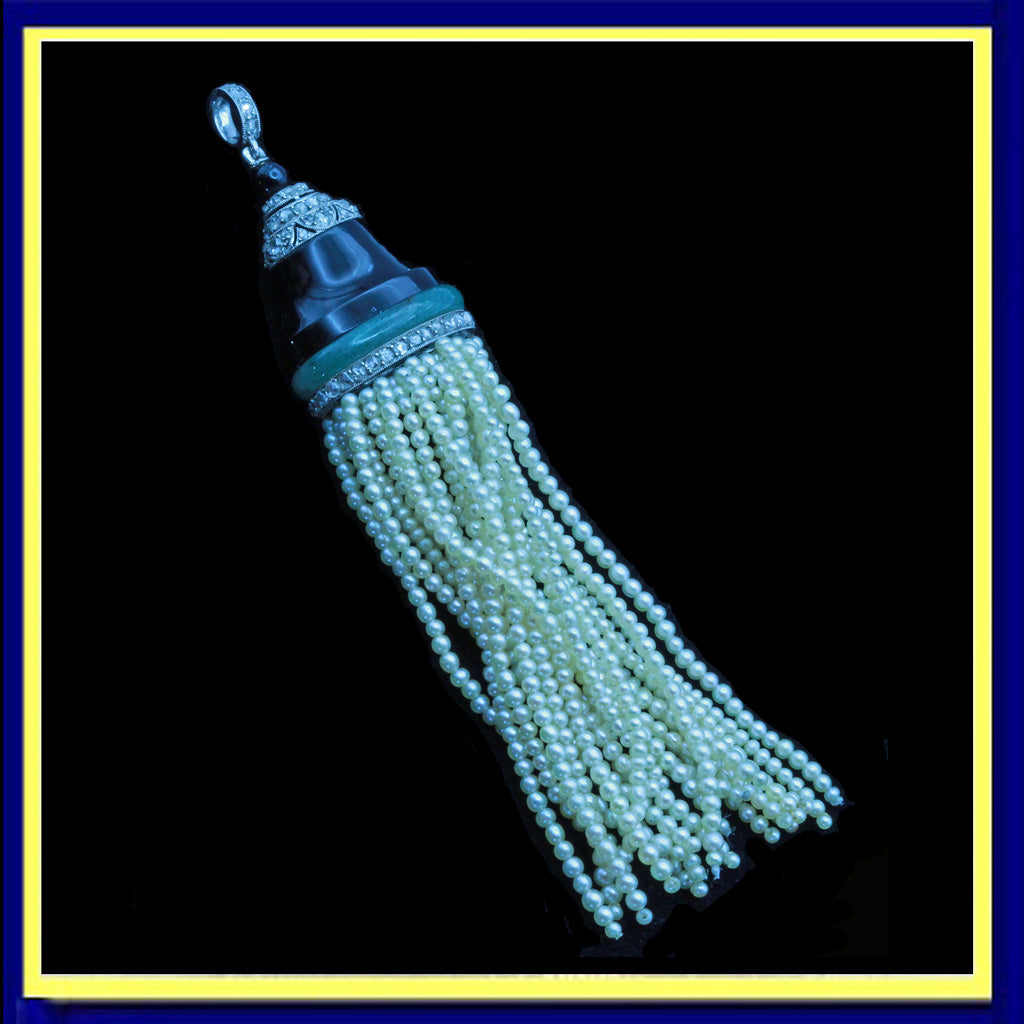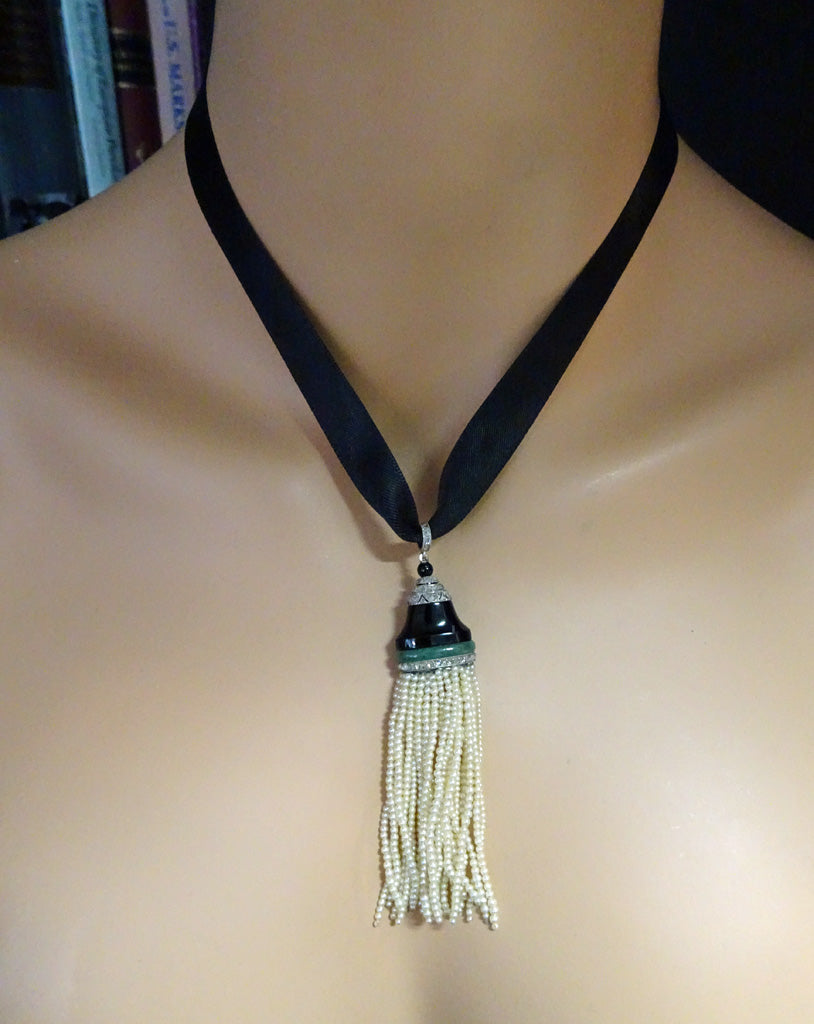Brenda Ginsberg Antique Jewelry
Cartier Antique Art Deco pendant platinum diamonds onyx jade pearls (7382)
Cartier Antique Art Deco pendant platinum diamonds onyx jade pearls (7382)
Regular price
$49,999.00 USD
Regular price
Sale price
$49,999.00 USD
Unit price
per
Couldn't load pickup availability
Antique Art Deco pendant. Platinum, diamonds, jade, onyx and pearls. Made in France circa 1920's (see date below). Signed Cartier.
Measurements: Weight is 11.8 grams. Length, including the bale is a little under 3 1/2 inches (8.7cm).
Description : Exquisite original Art Deco pendant. Combines Art Deco architectural qualities with the superb workmanship of the Belle Epoque - Art Deco era and stringent standards of Louis Cartier. Shaped like a stepped vase or bell with a large bale at the top and a long, full fringe of pearl tassles at the bottom.
The platinum oval bale is pave set with diamonds on the front. The bale is large enough to accommodate a large chain, ribbon or even a string of pearls.
The bale is connected to a black onyx bead by a pair of small loops. The loops allow the pendant to swing freely and move independently of the bale.
Beneath the black onyx bead are 3 consecutive, graduated in size, oval rings of pave set diamonds in a millegrained platinum, openwork mount. Designed to allow maximum light between the layers and to reflect light off the diamonds. Smallest ring at the top and largest at the bottom.
The largest diamond ring is firmly connected to an onyx mid section with concave sides, elegantly curving and leading the eye up to the diamonds above. Onyx with homogenous black and sheeny surface.
In turn, the onyx section joins to a green tubular, ring of jade.
Finally, an oval band of pave set diamonds that support the sections above and echo the triple rings of diamonds near the top.
As though falling from a waterfall, numerous strands of well-matched, even-colored pearls form a full tassle. The mechanism by which these strands of pearls are attached to the main body of the pendant is totally ingenous. It appears that an openwork plaque of platinum is what holds the parts together, but in fact, there is a bolt underneath that opens the entire compact composition. The workmanship of the back and underneath sections are reflective of the superiority of the Cartier firm and why they led the world in fabulous jewelry for over a century.
The combination of black onyx, green jade and pave set diamonds was a favorite combination in Cartier's jewelry during the 1920's. Open any book on Cartier jewelry of the time and we will see variations of this theme - all elegant and gorgeous. The onyx is a great background and contrast to the colors, offsetting the other materials brilliantly - all perfectly balanced: the solid stones versus the fine pave setting of the diamonds; the contrast between light and dark; solid and detailed, black and white (onyx and pearls). Unconsicously, our eyes are mesmerised.
Date: from at least 1910, Cartier made wonderful tassled pendants, not highly dis-similar to this one. It would be easy to ascribe this pendant to the Belle Epoque era, but considering the strong architectural form and color combinations, we feel it is more likely a little later and attribute it to the Art Deco period.
Marks and Metal: The back of the pendant has the following marks: CARTIER in block letters; dog facing right - platinum 950 hallmark, used 1912-1994; makers mark lozenge not properly legible. At the time, various workshops produced jewelry for Cartier, which might be reflected in the indistinct maker's mark.
The bale has the same maker's mark as well as the dog's head mark and other more indistinct marks.
There is a numeral, largely illegible on the underside, at the edge, near the 'key' that opens the pendant. Numerals include ?96 and are believed to be a model number.
Condition: Good with negligible wear commensurate with age. When we got the pendant, the threads holding the pearls were disintegrating, so we had them restrung. Please see enlarged pictures and don't hesitate to ask questions which we will do our best to answer.
THE STORY:
Who owned this amazing pendant? Was she a wealthy flapper, leader of the fashion world, visiting Paris from New York? Only a wealthy woman could have bought this pendant. Only a highly fashion-conscious person would understand and appreciate the Art Deco design and magnificent workmanship. Perhaps this explains how the pendant came from France to the New World.
How was this pendant worn by the original owner? During the 1920's, it was almost certain that the woman who wore this, had a long sautoir - a very long necklace that would reach down past her belly button. Very possibly, a very long strand of pearls. As she danced the night away at sophisticated parties, the necklace would swing and sway to her movements and the pendant would do the same with the tassles flying.
View full details
Measurements: Weight is 11.8 grams. Length, including the bale is a little under 3 1/2 inches (8.7cm).
Description : Exquisite original Art Deco pendant. Combines Art Deco architectural qualities with the superb workmanship of the Belle Epoque - Art Deco era and stringent standards of Louis Cartier. Shaped like a stepped vase or bell with a large bale at the top and a long, full fringe of pearl tassles at the bottom.
The platinum oval bale is pave set with diamonds on the front. The bale is large enough to accommodate a large chain, ribbon or even a string of pearls.
The bale is connected to a black onyx bead by a pair of small loops. The loops allow the pendant to swing freely and move independently of the bale.
Beneath the black onyx bead are 3 consecutive, graduated in size, oval rings of pave set diamonds in a millegrained platinum, openwork mount. Designed to allow maximum light between the layers and to reflect light off the diamonds. Smallest ring at the top and largest at the bottom.
The largest diamond ring is firmly connected to an onyx mid section with concave sides, elegantly curving and leading the eye up to the diamonds above. Onyx with homogenous black and sheeny surface.
In turn, the onyx section joins to a green tubular, ring of jade.
Finally, an oval band of pave set diamonds that support the sections above and echo the triple rings of diamonds near the top.
As though falling from a waterfall, numerous strands of well-matched, even-colored pearls form a full tassle. The mechanism by which these strands of pearls are attached to the main body of the pendant is totally ingenous. It appears that an openwork plaque of platinum is what holds the parts together, but in fact, there is a bolt underneath that opens the entire compact composition. The workmanship of the back and underneath sections are reflective of the superiority of the Cartier firm and why they led the world in fabulous jewelry for over a century.
The combination of black onyx, green jade and pave set diamonds was a favorite combination in Cartier's jewelry during the 1920's. Open any book on Cartier jewelry of the time and we will see variations of this theme - all elegant and gorgeous. The onyx is a great background and contrast to the colors, offsetting the other materials brilliantly - all perfectly balanced: the solid stones versus the fine pave setting of the diamonds; the contrast between light and dark; solid and detailed, black and white (onyx and pearls). Unconsicously, our eyes are mesmerised.
Date: from at least 1910, Cartier made wonderful tassled pendants, not highly dis-similar to this one. It would be easy to ascribe this pendant to the Belle Epoque era, but considering the strong architectural form and color combinations, we feel it is more likely a little later and attribute it to the Art Deco period.
Marks and Metal: The back of the pendant has the following marks: CARTIER in block letters; dog facing right - platinum 950 hallmark, used 1912-1994; makers mark lozenge not properly legible. At the time, various workshops produced jewelry for Cartier, which might be reflected in the indistinct maker's mark.
The bale has the same maker's mark as well as the dog's head mark and other more indistinct marks.
There is a numeral, largely illegible on the underside, at the edge, near the 'key' that opens the pendant. Numerals include ?96 and are believed to be a model number.
Condition: Good with negligible wear commensurate with age. When we got the pendant, the threads holding the pearls were disintegrating, so we had them restrung. Please see enlarged pictures and don't hesitate to ask questions which we will do our best to answer.
THE STORY:
Who owned this amazing pendant? Was she a wealthy flapper, leader of the fashion world, visiting Paris from New York? Only a wealthy woman could have bought this pendant. Only a highly fashion-conscious person would understand and appreciate the Art Deco design and magnificent workmanship. Perhaps this explains how the pendant came from France to the New World.
How was this pendant worn by the original owner? During the 1920's, it was almost certain that the woman who wore this, had a long sautoir - a very long necklace that would reach down past her belly button. Very possibly, a very long strand of pearls. As she danced the night away at sophisticated parties, the necklace would swing and sway to her movements and the pendant would do the same with the tassles flying.
























